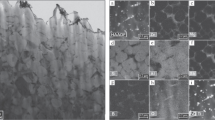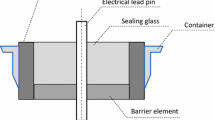Summary
-
1.
The alkali -stabilities of glasses of the type (87 -−x)%SiO2, −x%RO, 13%Na2O (R is Be, Mg, Ca, Sr, Ba, Zn, Cd, or Pb), binary sodium silicate glasses containing 13–33 moles %Na2O, and titanium-containing flint glasses were determined by measuring the thickness of the dissolved layer interferometrically.
-
2.
It was shown that, with the exception of beryllium oxide, all oxides introduced into the binary glass in place of silica lower the alkali-stability of the glass. At first (up to 22 % RO), the lowering is only slight and the glasses differ little in alkali-stability. When the amount of silica replaced by metal oxide is higher than this, there is a considerable fall in stability; this fall is the greater, the greater the ionic radius of the metal introduced (ionic-radius rule).
-
3.
For sodium oxide contents of up to 20 moles percent, binary sodium silicate glasses are fairly stable. Titanium affects stability to alkali in the same way as lead.
Similar content being viewed by others
Literature cited
V. S. Molchanov and O. S. Molchanov, Trans. State Optical Inst. No. 146, 1956.
R. Pike and D. Hubbard, J. Res. Nat. Bur., Stand. 50, No. 2, 87 (1953).
V. S. Molchanov and N. E. Prikhid'ko, Bull. Acad. Sci. USSR, Div. Chem. Sci. 1957, 1151.
S. K. Dubrovo and Iu. A. Shmidt, Bull. Acad. Sci. USSR, Div. Chem. Sci. 1955, 403.
A. G. Betekht, Mineralogy, State Geol. Press, Moscow, 1950.
O. K. Botvinkin and B. V. Tarasov, Glass and Ceramics, No. 7, 7 (1954).
German Patent 710079, abstracted in Glas. Techn. Ber. 19, 402 (1941).
I. I. Kitaigorodskif and L. S. Lande, in the Collection “Effect of Composition on the Physicochemical Properties of Glasses,” Trans, State Glass Inst., Moscow, 1954, p, 27.
I. Sawai and H. Usidima, abstracted in Glas. Techn. Ber. 20, 235 (1942).
M. A. Bezborodov and I. I. Kisel', Proc. Acad. Sci. USSR, 103, 1073 (1955).
M. G. Chemiak, Effect of Composition on the Physicochemical Properties of Glass, Trans. State Glass Inst., Moscow, 1934, p. 64.
M. A. Bezborodov, J. Soc. Glas. Techn. 28, 113 (1944).
E. Hamilton, O. Grauer, Z. Zabawsky and C. Hahner, J. Am. Ceram. Soc. 31, No. 5, 132 (1948).
W. Turner and V. Dimbleby, J. Soc. Glas. Techn., 10, 304 (1926); 12, 52 (1928).
H. Wessel, Silikattechnik 3, No. 11, 483 (1952).
R. L. Miuller and Ts. V. Vainshtein, J. Phys. Chem. 7, No. 3, 364 (1936).
Author information
Authors and Affiliations
Rights and permissions
About this article
Cite this article
Molchanov, V.S., Prikhid'ko, N.E. Corrosion of silicate glasses by alkaline solutions Communication 2. Relation between the stability of glasses to alkali and their compositions. Russ Chem Bull 7, 1–4 (1958). https://doi.org/10.1007/BF01170852
Received:
Issue Date:
DOI: https://doi.org/10.1007/BF01170852




